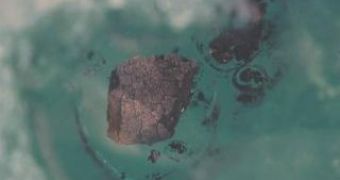Carbon and water rich meteorites fall on Earth once or twice every few decades. But when a truck-sized meteorite crashed on frozen Tagish Lake in western Canada in 2000, researchers got a specimen speckled with stardust that could offer clues about the chemistry of our early solar system.
Ancient meteorites may have delivered the raw materials for the emergence of life on Earth. The organic globules found on meteorite could be older than our Solar System.
Analysis proved they are not terrestrial contaminants. The hollow spheres could have provided a protective envelope for the raw organic molecules. Dr Lindsay Keller of NASA's Johnson Space Center (JSC) in Houston, Texas, thinks that such structures were precursors of the cell wall even if the globules in Tagish Lake were in no way equivalent to a cell. The hollow spheres are empty, but they do have organic molecules on their surfaces.
Mike Zolensky, a NASA mineralogist, said: "If, as we suspect, this type of meteorite has been falling on to Earth throughout its entire history, then the Earth was seeded with these organic globules at the same time life was first forming here."
Keiko Nakamura-Messenger of JSC told: "We reported only 26 globules in this paper, because they are small and hard to analyze. But we have seen hundreds in a small area. We can estimate that there are billions of them in this meteorite."
The ratios of hydrogen and nitrogen in the meteorite are very odd, strengthening the fact that the structures did not come from the Earth. Similar to particles found in comets, the submicroscopic globules in the Tagish Lake meteorite consist predominantly of carbon, hydrogen, nitrogen and oxygen. "The isotopic ratios in these globules show that they formed at temperatures of about -260C, near absolute zero," said co-author Scott Messenger, also from Johnson Space Center. "The organic molecules most likely originated in the cold molecular cloud that gave birth to our Solar System, or at the outermost reaches of the early Solar System."
The globules may initially have formed as organic ice grains whose exteriors were chemically converted to more refractory compounds when hit with ultraviolet radiation, but the center later evaporated, leaving a hollow sphere of organic matter. Alternatively, the alkaline solutions in the Tagish Lake meteorite's parent asteroid hollowed out the center.
In either case, the globules formed in the outskirts of our solar system. Zolensky said that meteorites are "a possible habitat to protect and shield organic chemistry." He adds that because these meteorites presumably fell on the early Earth, they may have delivered the globular "building blocks toward life." "We're sure that these [globules] are not alive," Messenger remarks. "But they may have been important ingredients for the first life-forms."
Researchers have been searching organic matter from meteorites for at least 40 years. Meteorites enter Earth's atmosphere frozen, the ideal state for chemical investigation but they usually thaw or wet or contaminate with terrestrial matter before they can be preserved. Scientists value the Tagish Lake meteorite, because it fell on a remote icy lake and was carefully handled. It has been maintained in a frozen state, minimizing the potential for terrestrial contamination.

 14 DAY TRIAL //
14 DAY TRIAL //